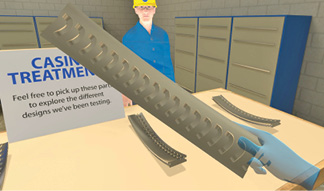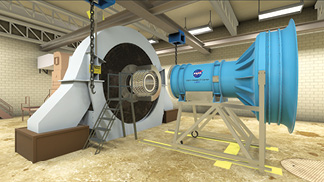Virtual reality designer surprised to win real medal from NASA
by Erica Peterson
When Paul A. Catalano Jr. opened an email from NASA telling him he received the organization’s Exceptional Public Service Medal, he assumed it was spam.
“I hadn’t had enough coffee yet,” he said with a laugh.
But when the Sagamore Hills resident received more emails from his managers and peers congratulating him, he realized the honor was real.
Catalano is employed by DB Consulting Group as a virtual reality application developer and has worked with NASA Glenn Research Center in Cleveland as a contractor since 2001.
He is in the Graphics and Visualization Lab, which works with NASA Glenn scientists and engineers to create custom graphic applications of their projects, including virtual designs and interactive 3D simulations.
“I work in scientific visualization, and that basically means taking either our scientists’ or researchers’ raw data and making pretty pictures out of it,” Catalano said.
His specialty is creating virtual reality applications to help explain different tests and experiments to a wide variety of audiences, from NASA management and politicians to the public.
The GVIS lab does a lot of outreach as well, including tours and conferences (pre-COVID) and working with local facilities like the Cleveland Museum of Natural History and the Great Lakes Science Center.
Catalano received the Exceptional Public Service Medal “for exceptional creativity and development of visualizations highlighting NASA technologies, facilities, and projects.” The U.S. government award goes to non-government individuals for sustained performance on multiple contributions to NASA projects.
The award ceremony was held virtually in December.
Catalano was recognized for his work on a virtual test facility called W1A, but he was nominated in a letter by his GVIS Lab peers in appreciation of his 20-year career with NASA.
“It is very humbling to see what your team feels about the work that you’ve done,” Catalano said.
NASA Glenn specializes in aeronautics and has a number of test facilities. His W1A Test Facility application allows users anywhere to put on a VR headset and “walk through” that engine design test area.
“The virtual walkthrough has an avatar that pops up, kind of like a tour guide, that tells you what it is we are testing in this facility,” Catalano explained. “In virtual reality, you can pick up parts and take a look at them in 3D. And then there’s a stage where it shrinks you down and sticks you inside the engine, as if you were inside during a test.”
The idea is to boil down complicated concepts and processes into a short, understandable, interactive experience, he said.
Because Catalano doesn’t have a background in aerospace, that can be challenging. But it’s also rewarding.
“I act as kind of an intermediary between the very smart researchers and engineers and the public who doesn’t necessarily have that background,” he said.
Catalano developed most of the W1A Test Facility visualization himselfZ over the course of a year. Much of the modeling was done by intern Dylan Payne.
Catalano is quick to credit interns for their contributions to the lab.
“Our group has fostered a lot of interns and tried to develop the talent of both local folks and people interning from out of state,” he said. “They are a real asset. I’m always impressed by the folks who come through there.”
Catalano grew up in Stow, went to Walsh Jesuit High School and graduated from Kent State in 2000 with a bachelor in computer science. He’s lived in the township since 2008.
When Catalano applied to college, he wasn’t sure what he was going to study, but he had always been into computer programming, thanks to the tutelage of his late father, Paul Catalano Sr.
He never considered computer graphics, because he didn’t consider himself artistic. That changed when he took computer graphics as an elective and created things he never thought possible.
“I really liked it. I thought it was fascinating,” Catalano said.
When he started with NASA Glenn, the lab was just developing virtual reality programs.
“VR has gone in these waves of public interest,” he said. “Twenty years ago, it was very, very niche. The headsets were really expensive and not mass-market products. And people didn’t have the computers at home to run them.”
By 2015, virtual reality had become more accessible. “Laptop computers and phones have enough capability that you can do VR at home at a cost that is reasonable compared to 20 years ago,” Catalano said.
His lab has benefited from that boom, as it can buy enough consumer equipment to share its work more widely.
Catalano has been working from his Sagamore Hills home since the pandemic shutdowns last year. He is looking forward to being able to return to the NASA Glenn facility with his co-workers.
“I love working at Glenn, and I love the people I work with,’’ he said. “Over the years, I’ve worked with a great team of very supportive and awesome teammates.”
Feature image photo caption: Software developer Paul A. Catalano Jr. created a virtual reality application that allows users anywhere to put on a headset and virtually walk through the NASA Glenn Research Center engine design test facility. He earned NASA’s Exceptional Public Service Medal for that application and in recognition of his 20-year career as a contractor at NASA Glenn. Photos courtesy of Paul. A Catalano Jr.



